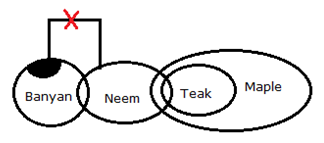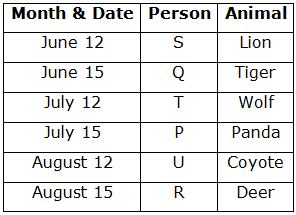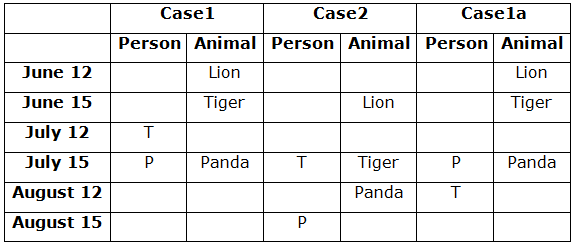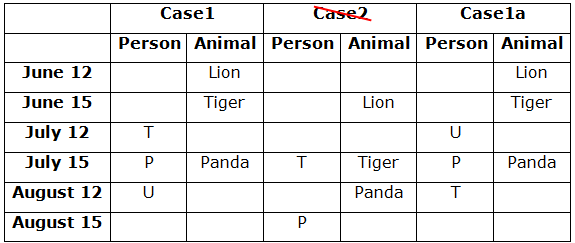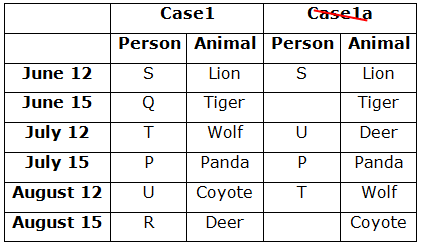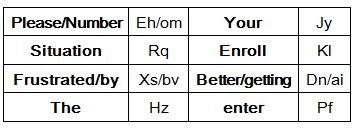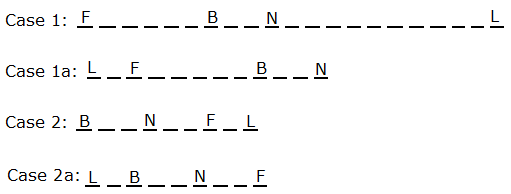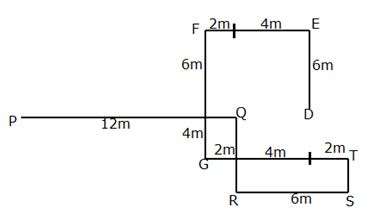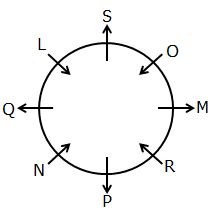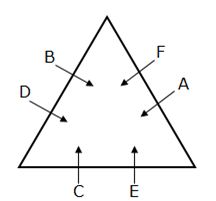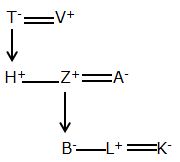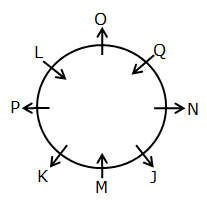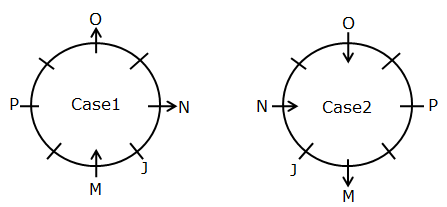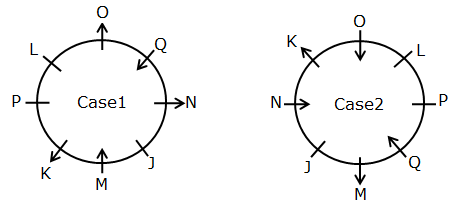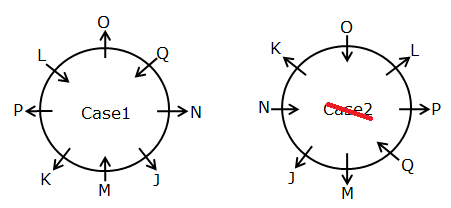IDBI Executive Mock Test - 1 - Bank Exams MCQ
30 Questions MCQ Test - IDBI Executive Mock Test - 1
Study the following information carefully and answer the questions given below.
Six persons I, J, K, L, M and N are living in two different flats viz., Flat A and Flat B of a three-storey building, but not necessarily in the same order. Flat A is to the west of Flat B. The lowermost floor is numbered as 1 and the floor immediately above is numbered as 2 and so on. Each of them prepares different sweets for Diwali- Laddu, Barfi, Jalebi, Rabri, Modak, and Kajukatli, but not necessarily in the same order.
The one who prepares Barfi lives two floors below J in the same flat. J lives to the north of the one who prepares Modak. M lives two floors above the one who prepares Jalebi which is not prepared by K. As many floors between the one who prepares Barfi and N as between N and the one who prepares Laddu, who lives immediately above L’s flat. I and N live in different flats. The one who prepares Rabri and I are not living on adjacent floors. The one who prepares Rabri lives in flat B.
Q. Who among the following person lives on floor number 1 of flat A?
Six persons I, J, K, L, M and N are living in two different flats viz., Flat A and Flat B of a three-storey building, but not necessarily in the same order. Flat A is to the west of Flat B. The lowermost floor is numbered as 1 and the floor immediately above is numbered as 2 and so on. Each of them prepares different sweets for Diwali- Laddu, Barfi, Jalebi, Rabri, Modak, and Kajukatli, but not necessarily in the same order.
The one who prepares Barfi lives two floors below J in the same flat. J lives to the north of the one who prepares Modak. M lives two floors above the one who prepares Jalebi which is not prepared by K. As many floors between the one who prepares Barfi and N as between N and the one who prepares Laddu, who lives immediately above L’s flat. I and N live in different flats. The one who prepares Rabri and I are not living on adjacent floors. The one who prepares Rabri lives in flat B.
Study the following information carefully and answer the questions given below.
Six persons I, J, K, L, M and N are living in two different flats viz., Flat A and Flat B of a three-storey building, but not necessarily in the same order. Flat A is to the west of Flat B. The lowermost floor is numbered as 1 and the floor immediately above is numbered as 2 and so on. Each of them prepares different sweets for Diwali- Laddu, Barfi, Jalebi, Rabri, Modak, and Kajukatli, but not necessarily in the same order.
The one who prepares Barfi lives two floors below J in the same flat. J lives to the north of the one who prepares Modak. M lives two floors above the one who prepares Jalebi which is not prepared by K. As many floors between the one who prepares Barfi and N as between N and the one who prepares Laddu, who lives immediately above L’s flat. I and N live in different flats. The one who prepares Rabri and I are not living on adjacent floors. The one who prepares Rabri lives in flat B.
Q. Which of the following statement(s) is/are false with respect to the final arrangement?
Six persons I, J, K, L, M and N are living in two different flats viz., Flat A and Flat B of a three-storey building, but not necessarily in the same order. Flat A is to the west of Flat B. The lowermost floor is numbered as 1 and the floor immediately above is numbered as 2 and so on. Each of them prepares different sweets for Diwali- Laddu, Barfi, Jalebi, Rabri, Modak, and Kajukatli, but not necessarily in the same order.
The one who prepares Barfi lives two floors below J in the same flat. J lives to the north of the one who prepares Modak. M lives two floors above the one who prepares Jalebi which is not prepared by K. As many floors between the one who prepares Barfi and N as between N and the one who prepares Laddu, who lives immediately above L’s flat. I and N live in different flats. The one who prepares Rabri and I are not living on adjacent floors. The one who prepares Rabri lives in flat B.
Study the following information carefully and answer the questions given below.
Six persons I, J, K, L, M and N are living in two different flats viz., Flat A and Flat B of a three-storey building, but not necessarily in the same order. Flat A is to the west of Flat B. The lowermost floor is numbered as 1 and the floor immediately above is numbered as 2 and so on. Each of them prepares different sweets for Diwali- Laddu, Barfi, Jalebi, Rabri, Modak, and Kajukatli, but not necessarily in the same order.
The one who prepares Barfi lives two floors below J in the same flat. J lives to the north of the one who prepares Modak. M lives two floors above the one who prepares Jalebi which is not prepared by K. As many floors between the one who prepares Barfi and N as between N and the one who prepares Laddu, who lives immediately above L’s flat. I and N live in different flats. The one who prepares Rabri and I are not living on adjacent floors. The one who prepares Rabri lives in flat B.
Q. Which of the following sweet is prepared by N?
Six persons I, J, K, L, M and N are living in two different flats viz., Flat A and Flat B of a three-storey building, but not necessarily in the same order. Flat A is to the west of Flat B. The lowermost floor is numbered as 1 and the floor immediately above is numbered as 2 and so on. Each of them prepares different sweets for Diwali- Laddu, Barfi, Jalebi, Rabri, Modak, and Kajukatli, but not necessarily in the same order.
The one who prepares Barfi lives two floors below J in the same flat. J lives to the north of the one who prepares Modak. M lives two floors above the one who prepares Jalebi which is not prepared by K. As many floors between the one who prepares Barfi and N as between N and the one who prepares Laddu, who lives immediately above L’s flat. I and N live in different flats. The one who prepares Rabri and I are not living on adjacent floors. The one who prepares Rabri lives in flat B.
Read the conclusions and then decide which of the given conclusions logically follows from the given statements disregarding commonly known facts.
Q. Statement
Only a few Banyan are Neem
Some Neem is Teak
All Teak are Maple
Conclusion
I. Some Banyan is not a Neem
II. Some Neem is Maple
III. All Banyan can never be Maple
Study the following information carefully and answer the questions given below:
Six persons- P, Q, R, S, T, and U are visited the Zoo on different months- June, July, and August on different dates either 12 or 15 of the same year. They like different animals.
P visited on an odd number date and visited two persons after the one who likes Tiger. The one who likes Panda visited three persons after the one who likes Lion. The one who likes Panda did not visit at last. T visited adjacent to the one who likes Panda. The number of persons visited before T is one more than the number of persons visited after U. The number of persons visited between the one who likes Lion and T is the same as the number of persons visited between the one who likes Wolf and S. Neither R nor Q likes Coyote. R visited after Q who does not like Lion. The one who likes Deer did not visit in the same month of T. Q does not like Deer.
Q. On which of the following month and Date does the one who likes Coyote visit?
Study the following information carefully and answer the questions given below:
Six persons- P, Q, R, S, T, and U are visited the Zoo on different months- June, July, and August on different dates either 12 or 15 of the same year. They like different animals.
P visited on an odd number date and visited two persons after the one who likes Tiger. The one who likes Panda visited three persons after the one who likes Lion. The one who likes Panda did not visit at last. T visited adjacent to the one who likes Panda. The number of persons visited before T is one more than the number of persons visited after U. The number of persons visited between the one who likes Lion and T is the same as the number of persons visited between the one who likes Wolf and S. Neither R nor Q likes Coyote. R visited after Q who does not like Lion. The one who likes Deer did not visit in the same month of T. Q does not like Deer.
Q. The one who visited on June 12 likes__?
Study the following information carefully and answer the questions given below:
Six persons- P, Q, R, S, T, and U are visited the Zoo on different months- June, July, and August on different dates either 12 or 15 of the same year. They like different animals.
P visited on an odd number date and visited two persons after the one who likes Tiger. The one who likes Panda visited three persons after the one who likes Lion. The one who likes Panda did not visit at last. T visited adjacent to the one who likes Panda. The number of persons visited before T is one more than the number of persons visited after U. The number of persons visited between the one who likes Lion and T is the same as the number of persons visited between the one who likes Wolf and S. Neither R nor Q likes Coyote. R visited after Q who does not like Lion. The one who likes Deer did not visit in the same month of T. Q does not like Deer.
Q. How many persons are visited after the one who likes Coyote?
Study the following information carefully and answer the questions given below
In a certain code language
“Please enroll your number” means “kl jy om eh”
“Frustrated by the situation” means “rq hz bv xs”
“Your situation getting better” means “ai rq jy dn”
“Enter the number please” means “eh hz pf om”
Q. What does the code “xs rq hz” represent in the given code language respectively?
Study the following information carefully and answer the questions given below
In a certain code language
“Please enroll your number” means “kl jy om eh”
“Frustrated by the situation” means “rq hz bv xs”
“Your situation getting better” means “ai rq jy dn”
“Enter the number please” means “eh hz pf om”
Q. If “Better give number” is coded as “tw om dn”, then what is the code for the phrase “please getting enroll” respectively?
Study the following information carefully and answer the questions given below.
A certain number of persons are sitting in a straight line such that all of them are facing towards the north where none of the known persons are sitting adjacent to each other. Odd number of persons is sitting in the row but not more than 30.
Five persons are sitting between F and B who sits third to the left of N. The number of persons sitting between F and N is two less than the number of persons sitting between N and L. G sits fourth to the right of L and no one sits to the right of G. X sits fourth to the left of B where X doesn’t sit at any of the ends. The number of persons sitting between B and N is one more than the number of persons sitting between L and R. D sits fifth to the left of R. The number of persons sitting between N and D is one more than the total number of persons sitting to the left of F.
Q. Who among the following person is seated eleventh to the right of X?
Study the following information carefully and answer the questions given below.
A certain number of persons are sitting in a straight line such that all of them are facing towards the north where none of the known persons are sitting adjacent to each other. Odd number of persons is sitting in the row but not more than 30.
Five persons are sitting between F and B who sits third to the left of N. The number of persons sitting between F and N is two less than the number of persons sitting between N and L. G sits fourth to the right of L and no one sits to the right of G. X sits fourth to the left of B where X doesn’t sit at any of the ends. The number of persons sitting between B and N is one more than the number of persons sitting between L and R. D sits fifth to the left of R. The number of persons sitting between N and D is one more than the total number of persons sitting to the left of F.
Q. What is the position of G with respect to R?
Study the following information carefully and answer the questions.
The given line graph shows the number of white gowns sold by four different shops i.e. A, B, C and D and also given the number of pink gowns sold by four different shops and the number of yellow gowns sold by four different shops.
Note: The total number of gowns sold = The number of white gowns sold + The number of pink gowns sold + The number of yellow gowns sold.
Q. If the ratio of the number of white, pink and yellow gowns sold by shop E is 3:4:1 and the total number of gowns sold by shop E is 30 less than that of shop A, then find the number of white gowns sold by shop E?
Study the following information carefully and answer the questions.
The given line graph shows the number of white gowns sold by four different shops i.e. A, B, C and D and also given the number of pink gowns sold by four different shops and the number of yellow gowns sold by four different shops.
Note: The total number of gowns sold = The number of white gowns sold + The number of pink gowns sold + The number of yellow gowns sold.
Q. The total number of pink and yellow gowns sold by shop D is what percentage more than the number of white gowns sold by shop C?
Study the following information carefully and answer the questions.
The given line graph shows the number of white gowns sold by four different shops i.e. A, B, C and D and also given the number of pink gowns sold by four different shops and the number of yellow gowns sold by four different shops.
Note: The total number of gowns sold = The number of white gowns sold + The number of pink gowns sold + The number of yellow gowns sold.
Q. If the number of orange gowns sold by shop F is 5/3rd of the number of yellow gowns sold by shop C and 75% of the total number of orange gowns sold in shop F, then find the number of orange gowns unsold by shop F?
Study the following information carefully and answer the questions given below.
The given pie chart shows the percentage distribution of the total number of trains stopped in five stations namely A, B, C, D and E.
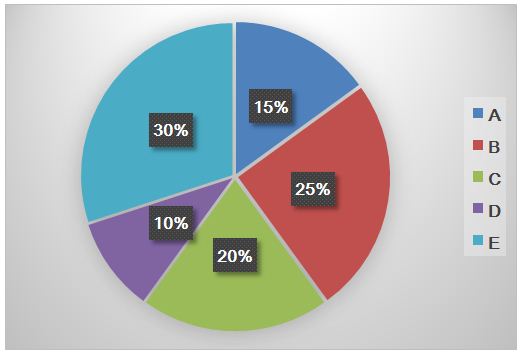
Note: The difference between the number of trains stopped in station C and station D is 120.
Q. In station B, three types of trains stopped namely express, superfast and local train. Out of total train stopped in station B, 20% are express trains and 40 trains are local trains. Find the number of superfast trains stopped in station B?
Study the following information carefully and answer the questions given below.
The given pie chart shows the percentage distribution of the total number of trains stopped in five stations namely A, B, C, D and E.

Note: The difference between the number of trains stopped in station C and station D is 120.
Q. Number of trains stopped in station G is 20% more than the number of trains stopped in station D. Find the number of trains stopped in station G?
Study the following information carefully and answer the questions given below.
The given table shows the total number of watches [analog+digital] sold in five different shops namely A, B, C, D and E and also given the total number of analog watches sold in five different shops.
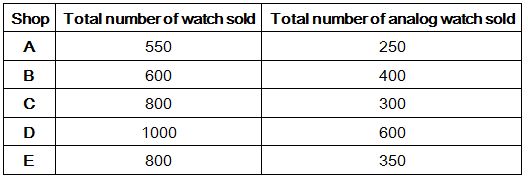
Q. The number of analog watches sold in shop F is 30% more than the number of analog watches sold in B and the number of digital watches sold in F is 30% less than the number of digital watches sold in shop C. Find the total number of watches sold in F?
Study the following information carefully and answer the questions given below.
The given table shows the total number of watches [analog+digital] sold in five different shops namely A, B, C, D and E and also given the total number of analog watches sold in five different shops.

Q. Find the difference between the number of analog watches sold in shop B and C together and the number of digital watches sold in shop D and E together?
Study the following information carefully and answer the questions given below.
The given table shows the total number of watches [analog+digital] sold in five different shops namely A, B, C, D and E and also given the total number of analog watches sold in five different shops.

Q. The total number of digital watches sold in A, B and C together is what percent of the total number of watches sold in shop D and E together?
Study the following information carefully and answer the questions given below.
Words arrangement machine when given an input line of words rearranges them following a particular rule in each step. The following is an illustration of input and rearrangement.
Input: Books Gifts Bikes Train Boxes
Step I: Train Books Gifts Bikes Boxes
Step II: Gifts Train Books Bikes Boxes
Step III: Bikes Gifts Train Books Boxes
Step IV: Books Bikes Gifts Train Boxes
Step V: Boxes Books Bikes Gifts Train
Input: Shirt Socks Roads Films Masks
Q. Which of the following word is second to the right of “Shirt” in thestep V?
Study the following information carefully and answer the questions given below.
Words arrangement machine when given an input line of words rearranges them following a particular rule in each step. The following is an illustration of input and rearrangement.
Input: Books Gifts Bikes Train Boxes
Step I: Train Books Gifts Bikes Boxes
Step II: Gifts Train Books Bikes Boxes
Step III: Bikes Gifts Train Books Boxes
Step IV: Books Bikes Gifts Train Boxes
Step V: Boxes Books Bikes Gifts Train
Input: Shirt Socks Roads Films Masks
Q. In which of the following steps “Socks Roads Films” is obtained in the same sequenceof order?
Study the following information carefully and answer the questions given below.
Person A starts walking from point P towards the east and walks for 12m to reach point Q then he turns to the right and walks for 8m to reach point R. Then he takes two consecutive left turns and walks for 6m and 4m to reach point S and T respectively.
Person B starts walking from point D towards the north and walks for 6m to reach point E then he turns to the left and walks for 6m to reach point F where he turns to the left and walks for 10m to reach point G then he turns to the left and walks for 8m to reach point T.
Q. What is the shortest distance between points Q and S?
Statements:
A. The price of petrol increased by 20% over the same period last year
B. The price of oil has comparatively come down during the past few weeks
If all the consonants of the word “CONTEMPORARY” which are immediately preceded by a vowel but not immediately followed by a vowel are changed to the next letter and arrange all the letters in alphabetical order from the left to right, then which of the following will be the fourth to left of the fifth letter from the right end of the word?
Study the following information carefully and answer the questions given below.
Eight persons - L, M, N, O, P, Q, R and S are sitting around a circular table such that the alternate persons face inside and outside, but not necessarily in the same order. Who among the person sits second to the right of R?
Statement I: N sits facing towards O, who sits second to the left of L. Q sits adjacent to L but not O. P sits immediate left of R, who is not adjacent to N. S is not adjacent to R.
Statement II: Both R and L face towards each other, where O sits adjacent to L. O is the immediate neighbour of S, who sits three persons away from P. R sits immediate right of M.
Study the following information carefully and answer the questions given below.
Six persons - A, B, C, D, E and F are sitting around a triangular table with two members on each side of the table and all of them are facing inside, but not necessarily in the same order. Who among them sits second to the right of A?
Statement I: D sits second to the left of E, who sits immediate left of A. Both B and F are the immediate neighbours but doesn’t sit on the same side.
Statement II: E sits between A and C, whereas B sits between D and F, who is the immediate neighbour of A and sits on the same side. C sits immediate left of E.
Study the following information carefully and answer the questions given below.
L is the only son of Z. T is the mother of Z. H is the brother-in-law of A, who is the Mother of only L and B. K is the sister-in-law B, who is unmarried. A is the Daughter-in-law of T. V is the father-in-law of A, who doesn’t have any siblings.
Q. If X is the spouse of H, then how is Z related to X?
Study the following information carefully and answer the questions given below.
Eight persons - J, K, L, M, N, O, P and Q are sitting around a circular table such that some of them are facing inside while some are facing outside the table, but not necessarily in the same order. Not more than two adjacent persons face the same direction.
M sits second to the right of N, where both are facing opposite directions. N sits opposite to P, who sits second to the left of O. Only two persons sit between J and O, when counted from the right of O. Both J and P face the same direction. Q faces inside. Only three persons sit between J and L, who sits second to the right of Q. Both K and Q face opposite directions. The number of persons facing outside is two more than the number of persons facing inside. L doesn’t face outside.
Q. Who among the following person sits third to the left of P?
Study the following information carefully and answer the questions given below.
Eight persons - J, K, L, M, N, O, P and Q are sitting around a circular table such that some of them are facing inside while some are facing outside the table, but not necessarily in the same order. Not more than two adjacent persons face the same direction.
M sits second to the right of N, where both are facing opposite directions. N sits opposite to P, who sits second to the left of O. Only two persons sit between J and O, when counted from the right of O. Both J and P face the same direction. Q faces inside. Only three persons sit between J and L, who sits second to the right of Q. Both K and Q face opposite directions. The number of persons facing outside is two more than the number of persons facing inside. L doesn’t face outside.
Q. Four of the following five are alike in a certain way as per the given arrangement and thus form a group. Find the one that doesn’t belong to that group.
Study the following information carefully and answer the questions given below.
Eight persons - J, K, L, M, N, O, P and Q are sitting around a circular table such that some of them are facing inside while some are facing outside the table, but not necessarily in the same order. Not more than two adjacent persons face the same direction.
M sits second to the right of N, where both are facing opposite directions. N sits opposite to P, who sits second to the left of O. Only two persons sit between J and O, when counted from the right of O. Both J and P face the same direction. Q faces inside. Only three persons sit between J and L, who sits second to the right of Q. Both K and Q face opposite directions. The number of persons facing outside is two more than the number of persons facing inside. L doesn’t face outside.
Q. Who among the following persons sit adjacent to Q?






